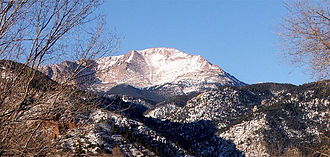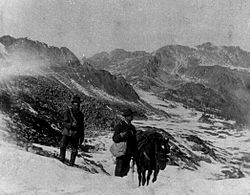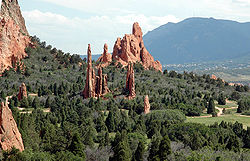- Real estate in Colorado Springs
-
The history of Colorado Springs real estate development began in the mid-nineteenth century when the early gold rush miners paved the way for cities and population booms. The mid-twentieth century saw a revitalized boom from declining growth following World War II with the beginning of the Korean War due to a massive increase in military expansion, as well as the scenic views of the picturesque landscape which many people flocked to see. Today, residents or those who have vacation homes in Colorado Springs, Colorado are attracted to the land because of the serene and peaceful surroundings of national historic parks and landmarks, and the beautiful mountains which can be seen from the many parts of the city.
Contents
Early Development
The early aspects of commercial development in Colorado Springs, Colorado occurred mostly because of the gold rush in the early-to-mid nineteenth century in the United States. This led to the influx of thousands miners who entered various mining districts mostly within the 2nd half of the nineteenth century, and even into the early twentieth-century. The first mining district in Colorado was The Gregory Mining District, founded in 1859[1] by the Scottish southerner and pioneer miner John H. Gregory (born December 27, 1820 – missing 1863)[2]. These times were very prosperous for both the mines and the government. (The Cresson Mine, located about 72 km (45 road. miles) southwest of Colorado Springs in the Cripple Creek Mining District[3], remains the state’s largest gold-producing mine today.[4])
Decline in Colorado’s Gold Rush
The decades before World War II saw a decline in the flow of gold and silver, which took with it both population and interest in commercial development in Colorado Springs. Once was a time when gold mining was prosperous in Pike’s Peak (located a few miles northeast of the Cripple Creek Mining District) who’s nearest city is Colorado Springs. Despite the decline in gold mining, an increase in tourism began, due to the breathe-taking scenery of Colorado Springs, which became a recuperation spot for tuberculosis patients.
 Pikes Peak, one of the most popular sights in Colorado Springs, here as seen from Manitou Springs, Colorado.
Pikes Peak, one of the most popular sights in Colorado Springs, here as seen from Manitou Springs, Colorado.
Post World War II Era and the Korean War Real Estate
The United States Army established Camp Carson in 1942 to train and house military troops at this new base in preparation for the World War II. The Carson base was eventually increased in size, which enlarged the city boundaries of Colorado Springs since the base was situated near its border. This expansion provided the city with enormous industrial growth. While post World War II displayed a decline in the Camp’s base to only 600 soldiers, the commencement of the Korean War reactivated it, as well as military enlistment in other parts of Colorado Springs. Furthermore, The United States Air Defense Command relocated to Colorado Springs and opened Ent Air Force Base (which was closed in the mid 1970’s and later converted into the United States Olympic Training Center).
In 1954, Colorado Springs became home to the Air Force's military academy. This and other military expansion led to significant enlargements of city limits and produced a boom in new industries and increased revenues. In fact, military expansion is continuing the growth of Colorado Springs today.
See also
- Homeowners' association
- Real-estate developer
- Real estate investing
- Real estate trends
- Real estate pricing
- Real estate economics
- List of real estate topics
- Real estate appraisal
- Housing Bubble
References
- ^ "Colorado Mining Bureau History." Retrieved on January 14, 2008.
- ^ "John H. Gregory." Retrieved on January 15, 2008.
- ^ "Cresson Mine Expands its Operations." Retrieved on January 15, 2008.
- ^ "Active Mines in Colorado." Retrieved on January 17, 2008.
Categories:- Pikes Peak
- Economy of Colorado Springs, Colorado
- History of Colorado Springs, Colorado
Wikimedia Foundation. 2010.


